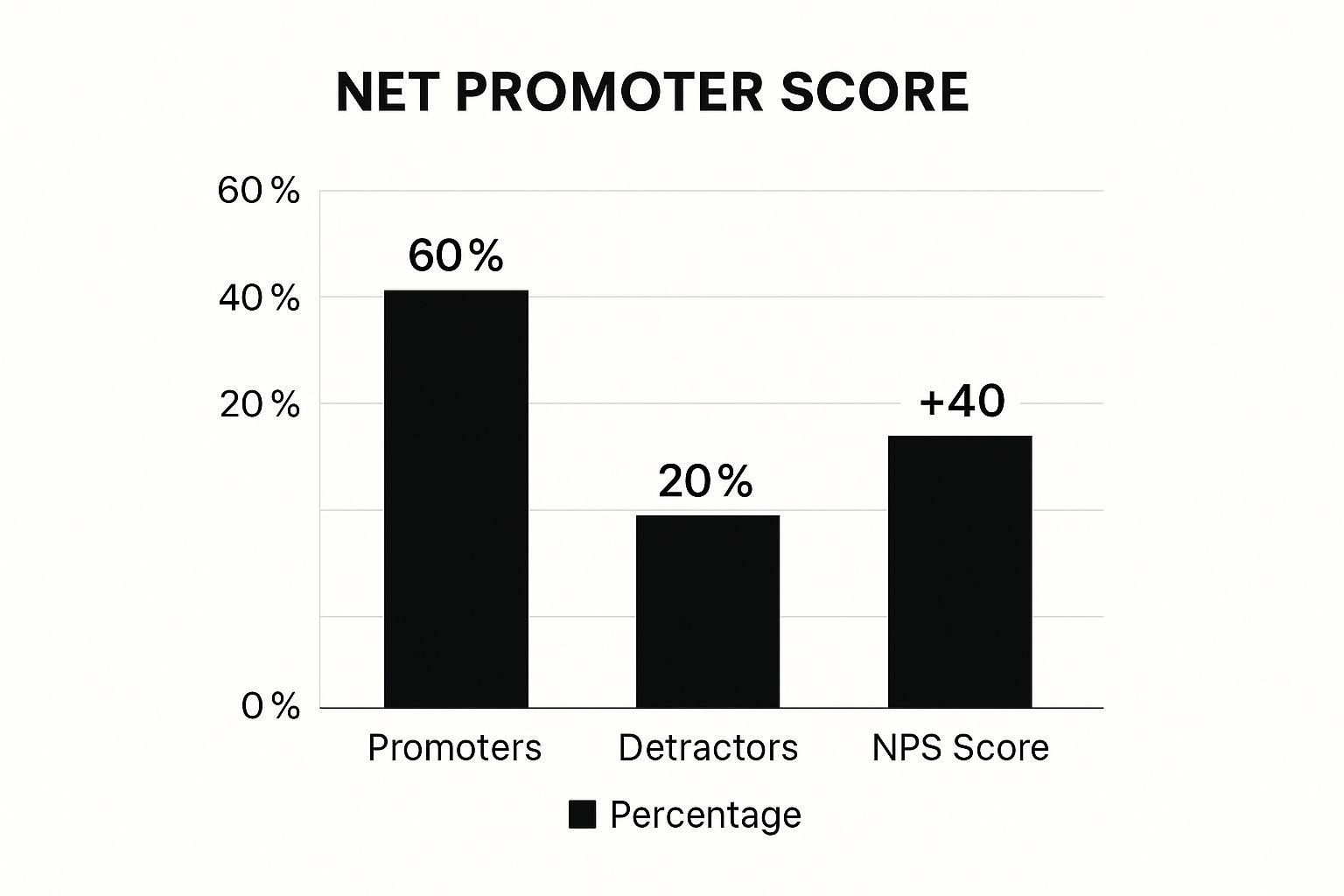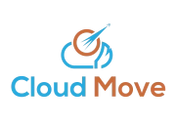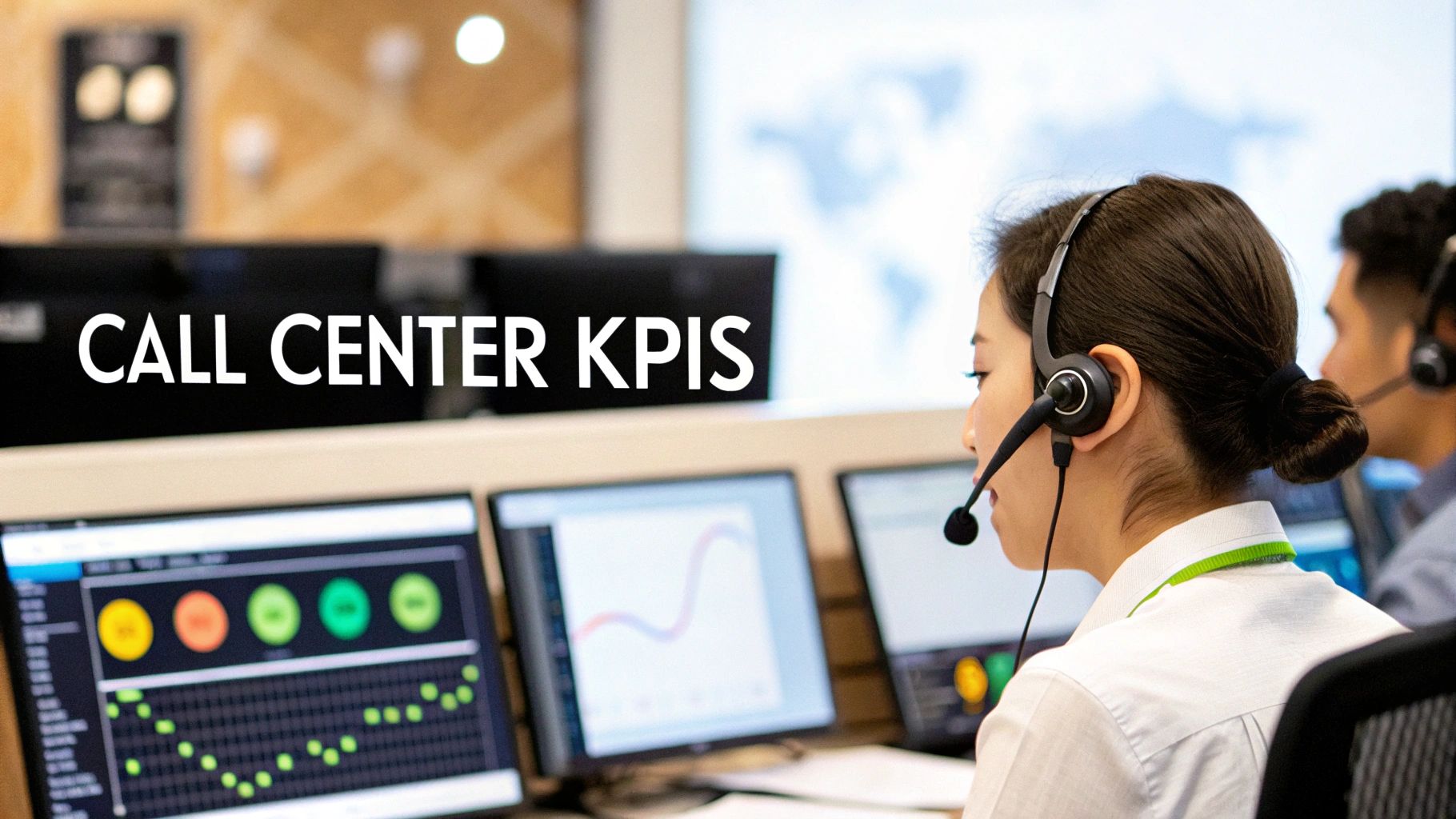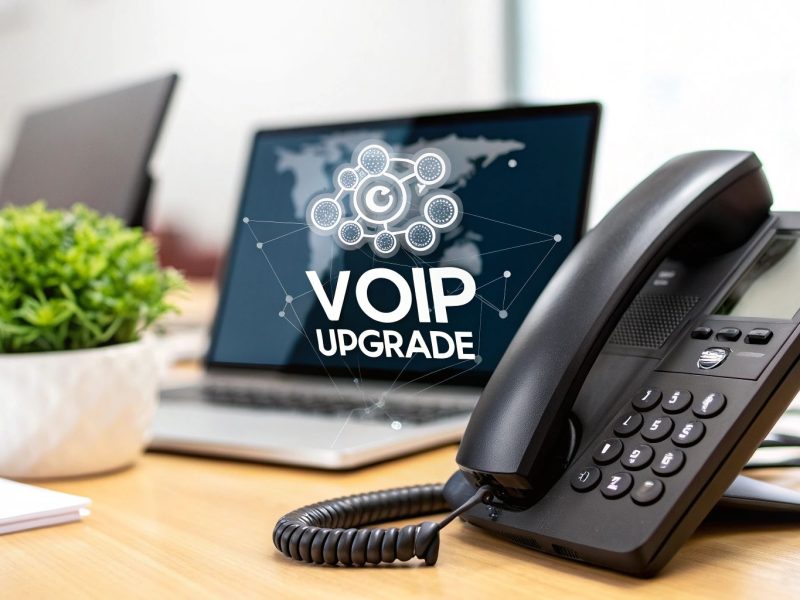Unlocking Call Center Excellence: The Power of KPIs
Want to boost your call center's performance? Tracking the right Key Performance Indicators (KPIs) is crucial. This listicle reveals 7 essential KPIs for call center success, helping you pinpoint areas for improvement and optimize operations. Learn how to measure vital metrics like Average Handle Time (AHT), First Call Resolution (FCR), and Customer Satisfaction (CSAT) to enhance customer experience and drive efficiency. Understanding these KPIs for call center management is key to staying competitive and achieving business objectives.
1. Average Handle Time (AHT)
Average Handle Time (AHT) is a crucial KPI for call centers, measuring the total duration of a customer interaction. This includes talk time, hold time, and after-call work, providing a comprehensive view of agent efficiency in resolving customer issues. It's a fundamental metric for understanding operational performance and identifying areas for improvement. AHT is one of the most closely monitored KPIs in call centers because it directly impacts both customer experience and operational costs. By optimizing AHT, businesses can improve efficiency, reduce costs, and enhance the customer journey.

Features:
- Calculation: (Total Talk Time + Total Hold Time + Total After-Call Work Time) / Total Number of Calls
- Measurement: Typically measured in minutes and seconds.
- Scope: Covers the entire customer interaction from start to finish.
- Segmentation: Often segmented by call type, agent, team, or time period for more granular analysis.
Pros:
- Visibility into Efficiency: Provides a clear picture of operational efficiency, enabling data-driven decision-making.
- Training Needs Identification: Helps pinpoint training needs for agents with consistently high AHT.
- Workforce Planning: Useful for accurate workforce planning and scheduling.
- Cost Reduction: Optimizing AHT can significantly reduce operational costs.
Cons:
- Potential for Reduced Quality: Overemphasis on AHT can lead to agents rushing calls and compromising service quality.
- Call Complexity: May not fully account for variations in call complexity.
- Customer Satisfaction: Not always a direct indicator of customer satisfaction.
- Agent Pressure: Can create undue pressure on agents if targets are unrealistic.
Examples of Successful Implementation:
- Amazon: Targets an AHT of 340 seconds (5:40) for standard service inquiries, demonstrating a focus on efficiency.
- American Express: Improved their AHT by 10% by implementing better knowledge management systems, highlighting the impact of readily available information.
- Zappos: Deliberately doesn't focus on AHT, prioritizing longer, relationship-focused calls for enhanced customer loyalty. This approach demonstrates that AHT strategies should align with overall business objectives.
Tips for Optimizing AHT:
- Balance with Quality: Balance AHT goals with quality metrics like customer satisfaction (CSAT) to avoid sacrificing service for speed.
- Segmentation: Segment AHT by call types (e.g., technical support, billing inquiries) to set realistic expectations for varying complexity levels.
- Call Recording Analysis: Analyze call recordings to identify common time-consuming scenarios and develop targeted solutions.
- Knowledge Management: Implement robust knowledge bases and scripts to empower agents and reduce handling time naturally.
- Seasonal Considerations: Account for seasonal variations in call volume and complexity when setting AHT targets.
Why AHT Deserves its Place in the List:
AHT is a foundational KPI for call centers because it provides a quantifiable measure of efficiency and directly impacts operational costs. It offers valuable insights into agent performance, training needs, and areas for process improvement. For businesses in the AE region seeking scalable contact center solutions or focusing on agent performance and reporting, monitoring and optimizing AHT is essential for achieving operational excellence and delivering a positive customer experience. For organizations in regulated sectors, AHT optimization can assist in streamlining processes while maintaining compliance.
2. First Call Resolution (FCR)
First Call Resolution (FCR) is a crucial KPI for call centers measuring the percentage of customer issues resolved during the initial contact, eliminating the need for follow-up calls or transfers. It's a powerful indicator of both operational efficiency and customer satisfaction, directly impacting a company's bottom line and customer loyalty. A high FCR signifies streamlined processes, knowledgeable agents, and satisfied customers, while a low FCR often points to systemic issues requiring attention. For businesses aiming to optimize their call center performance and enhance the customer experience, FCR deserves prominent consideration within their KPI framework.

FCR is calculated as: (Number of Issues Resolved on First Contact / Total Number of Issues) × 100, and is typically expressed as a percentage. Measurement can be achieved through various methods including post-call surveys, repeat call tracking, and quality monitoring. It's often considered the most important call center KPI concerning customer satisfaction, as resolving issues quickly and efficiently significantly impacts customer perception and loyalty.
Features and Benefits:
- Direct Correlation with Customer Satisfaction: A high FCR directly translates to happier customers who feel valued and heard.
- Cost Reduction: Fewer repeat calls mean lower operational costs associated with agent time, infrastructure, and resources.
- Training Enhancement: Analyzing failed FCR instances reveals training opportunities and knowledge gaps among agents.
- Improved Efficiency: Streamlined processes and empowered agents contribute to overall call center efficiency.
Pros:
- Directly correlates with customer satisfaction scores.
- Reduces operational costs by minimizing repeat calls.
- Identifies training opportunities and knowledge gaps.
- Improves overall call center efficiency.
Cons:
- Can be difficult to measure accurately without robust tracking systems.
- May encourage agents to spend excessive time on complex issues.
- Varying definitions of 'resolution' can lead to inconsistent results.
- Some issues inherently require multiple interactions.
Examples of Successful Implementation:
- TD Bank boosted FCR from 80% to 92% by deploying a new knowledge management system, empowering agents with readily available information.
- Apple maintains FCR rates above 90% through rigorous agent training and comprehensive product knowledge resources.
- Verizon Wireless utilizes FCR as a key performance indicator for both individual agents and teams, driving performance improvements.
Actionable Tips for Improvement:
- Define "Resolution": Establish clear definitions of what constitutes a resolved issue for various call types to ensure consistent measurement.
- Robust Tracking: Implement robust call tracking systems capable of identifying repeat callers and the reasons for their subsequent calls.
- Agent Empowerment: Empower agents with the authority to resolve issues without escalation whenever possible, streamlining the resolution process.
- Knowledge Base: Create comprehensive and easily accessible knowledge bases for agents to quickly access information during calls.
- Root Cause Analysis: Conduct thorough root cause analysis on failed FCR cases to identify systemic issues and implement targeted improvements.
When and Why to Use FCR:
FCR should be a primary KPI for any call center striving for operational efficiency and high customer satisfaction. It's particularly relevant for businesses operating in competitive landscapes where customer experience is a key differentiator. Implementing FCR as a core metric helps organizations identify areas for improvement, enhance agent performance, and ultimately deliver a superior customer experience. Whether you're a small business or a large enterprise, tracking and optimizing FCR is a vital step towards building a successful and customer-centric call center operation.
3. Customer Satisfaction Score (CSAT)
Customer Satisfaction Score (CSAT) is a crucial KPI for call centers in the AE region as it directly measures how satisfied customers are with the service they received during an interaction. This metric provides valuable insights into the customer experience and helps identify areas for improvement within your call center operations. CSAT is typically collected through post-call surveys that ask customers to rate their experience on a numerical scale, giving you immediate feedback on agent performance. This makes it a valuable tool for businesses looking for scalable contact center solutions and allows contact center supervisors and team leads to focus on agent performance and reporting.

CSAT is calculated by dividing the number of satisfied customers by the total number of survey responses and multiplying by 100. It's usually measured on a 1-5 or 1-10 scale, with responses of 4-5 or 8-10 generally considered "satisfied." These surveys can be administered via various channels like IVR surveys, email, SMS, or even during the call itself. Furthermore, CSAT data can be broken down by agent, team, call type, or time period to provide granular insights into performance. This granularity is particularly beneficial for enterprise IT managers seeking secure and flexible deployments, and customer experience teams aiming for unified multichannel engagement.
Features and Benefits:
- Direct Reflection of Customer Perception: CSAT offers a clear view of how customers perceive your service quality.
- Simplicity and Communicability: The score is easy to understand and communicate across all levels of your organization.
- Immediate Feedback: Provides real-time feedback on individual agent performance, facilitating targeted coaching and improvement initiatives.
- Correlation with Retention: High CSAT scores often correlate with improved customer retention and loyalty.
- Flexibility in Collection: The variety of collection methods allows you to choose the approach best suited to your customer base.
Pros and Cons:
- Pros: Directly reflects customer perception, simple to understand, provides immediate feedback, correlates with customer retention.
- Cons: Subject to response bias, potential for low response rates due to survey fatigue, may reflect factors outside agent control, single-point-in-time measurement.
Examples of Successful Implementation:
- Hilton Hotels maintains high CSAT scores through targeted agent coaching, demonstrating the impact of focused training on customer satisfaction.
- Discover Card links CSAT scores to agent compensation, incentivizing excellent service and achieving high satisfaction rates.
- Zappos prioritizes CSAT over efficiency metrics, showcasing a commitment to customer experience that leads to consistently high scores.
Tips for Effective CSAT Implementation:
- Keep surveys brief: Limit surveys to 1-3 questions to maximize response rates.
- Include open-ended questions: Gather qualitative feedback to gain deeper insights into customer experiences.
- Act on low scores: Address negative feedback promptly to recover dissatisfied customers and prevent churn.
- Link CSAT to agent behaviors: Utilize call monitoring to connect CSAT results with specific agent actions.
- Track trends: Monitor CSAT scores over time to identify patterns and measure the effectiveness of improvement initiatives.
Learn more about Customer Satisfaction Score (CSAT)
CSAT's position as a vital kpi for call center operations stems from its ability to directly link agent performance to customer perception. This is particularly important for organizations in regulated sectors like healthcare, finance, and logistics where compliance and customer trust are paramount. By consistently monitoring and improving CSAT, businesses in the AE region can enhance customer loyalty, drive positive word-of-mouth referrals, and ultimately boost their bottom line. Using CSAT as a KPI empowers your call center to become a key driver of customer satisfaction and business success.
4. Net Promoter Score (NPS)
Net Promoter Score (NPS) is a crucial KPI for call centers because it directly measures customer loyalty and satisfaction, providing valuable insights into the customer experience. It gauges how likely a customer is to recommend your company to others, offering a simple yet powerful way to understand customer perception. This metric works by asking a single, straightforward question: "On a scale of 0 to 10, how likely are you to recommend our company to a friend or colleague?" Based on their responses, customers are categorized into three groups: Promoters (9-10), Passives (7-8), and Detractors (0-6). The NPS is then calculated by subtracting the percentage of Detractors from the percentage of Promoters, resulting in a score ranging from -100 to +100.

The infographic above visually represents the NPS calculation and its interpretation. It highlights the distribution of Promoters, Passives, and Detractors and how their proportions influence the final NPS score. The color-coded categories make it easy to understand at a glance where your customer base lies on the spectrum of loyalty. For example, a large green section indicates a high percentage of Promoters, contributing to a positive NPS, while a larger red section signifies a higher percentage of Detractors and a lower overall score.
This single question approach, though simple, is surprisingly effective. It’s often followed by an open-ended question asking why the respondent gave that particular score, providing richer qualitative data. While the NPS is typically measured periodically rather than after every interaction, linking it to specific interactions when possible can unlock deeper insights into agent performance and specific customer journeys.
Features and Benefits:
- Simple Calculation: % Promoters – % Detractors = NPS
- Easy to Understand: The 0-10 scale is intuitive for both customers and employees.
- Benchmarking: Allows comparison against competitors and industry averages.
- Actionable Follow-up: Open-ended feedback provides context and areas for improvement.
- Correlation with Growth: NPS strongly correlates with customer lifetime value and business growth.
Pros:
- Easy to collect and understand
- Strong correlation with business growth and customer lifetime value
- Allows benchmarking against competitors and across industries
- Combines measurement with actionable follow-up
Cons:
- May not provide specific actionable insights without follow-up questions
- Cultural differences can affect scoring patterns internationally
- Single-question approach may oversimplify complex customer relationships
- Call center agents have limited influence over the entire customer experience
Examples of Successful Implementation:
- Apple consistently achieves NPS scores above 70 across their support channels.
- USAA maintains NPS scores above 80 in their contact centers through empathetic service.
- T-Mobile improved their NPS from negative to +30 as part of their 'Un-carrier' transformation.
Tips for Using NPS as a KPI for Call Center:
- Link to Interactions: Connect NPS feedback to specific agent interactions whenever possible.
- Analyze Verbatim Comments: Understand the reasoning behind the scores.
- Close the Loop: Address concerns and follow up with Detractors.
- Strategic Metric: Use NPS as a strategic metric rather than a daily operational KPI.
- Track Trends: Focus on trends over time rather than fixating on absolute numbers.
Why NPS Deserves its Place in Your Call Center KPIs:
For businesses in the AE region, understanding customer loyalty is paramount. NPS provides a concise and actionable metric that can be used to track customer sentiment, identify areas for improvement in service delivery, and ultimately drive business growth. Its simplicity, combined with its strong correlation to customer lifetime value, makes it an essential KPI for call centers looking to improve customer experience and foster loyalty. This metric provides a clear view of customer perception and allows for targeted improvements in service and operations. For organizations operating in regulated sectors like healthcare, finance, and logistics, NPS provides a crucial metric to track customer satisfaction and maintain compliance standards by ensuring high-quality service delivery. Whether you’re a small business or a large enterprise, NPS is an invaluable tool for measuring and improving customer relationships.
Popularized By:
- Fred Reichheld (Bain & Company)
- Harvard Business Review article "The One Number You Need to Grow"
- Satmetrix Systems, Inc.
5. Service Level/Response Time
Service Level/Response Time is a crucial KPI for call centers, directly impacting customer satisfaction and operational efficiency. It measures the percentage of calls answered within a predefined timeframe, reflecting how accessible and responsive your call center is. This KPI is typically expressed as "X percent of calls answered within Y seconds," often referred to as the "80/20" standard, meaning 80% of calls are answered within 20 seconds. Its prominent position in any call center KPI suite stems from its direct correlation with customer perception of service quality and its utility in optimizing resource allocation. This makes it a vital metric for businesses of all sizes, from small businesses to large enterprises, looking to enhance their customer experience.
How it Works:
Service Level is calculated using a simple formula:
(Calls Answered Within Threshold / Total Calls) × 100
Common thresholds include 20, 30, or 60 seconds, and the specific target is often dictated by industry best practices, internal goals, or even contractually mandated in Service Level Agreements (SLAs). Real-time monitoring of this KPI is essential for effective workforce management and intraday adjustments to staffing levels.
Features and Benefits:
- Real-time Measurement: Provides immediate feedback on call center performance, allowing for quick adjustments to staffing and processes.
- SLA Compliance: Helps ensure adherence to contractual obligations with clients regarding response times.
- Workforce Optimization: Enables data-driven decisions about staffing levels, scheduling, and break management.
- Clear Performance Indicator: Offers an easily understood metric to track progress and identify areas for improvement.
Pros:
- Clear indicator of call center accessibility.
- Easy to measure and track in real-time.
- Directly impacts customer perception of responsiveness.
- Helps optimize staffing levels and scheduling.
Cons:
- Focuses solely on speed, not quality of service. Overemphasis on speed can lead to rushed interactions and potentially lower resolution rates.
- Can lead to rushed greetings and poor call handling if overemphasized. Agents might prioritize answering calls quickly over providing thorough and helpful support.
- May encourage hanging up on customers to take new calls. While rare, the pressure to meet service level targets could incentivize undesirable agent behavior.
- Doesn't account for resolution effectiveness. A quickly answered call that doesn't resolve the customer's issue offers little value.
Examples of Successful Implementation:
- American Express reportedly targets a 90/20 service level, prioritizing rapid response times for their customer base.
- Emergency services like 911 maintain extremely high service levels, often 95/10 or higher, due to the critical nature of their calls.
- Delta Airlines has been known to improve their service level during peak travel seasons by leveraging forecasting models to optimize staffing levels.
Actionable Tips for Improving Service Level:
- Segment Your Targets: Set different service level targets for different customer segments or call types. High-value customers or complex inquiries might warrant faster response times.
- Holistic View: Use service level alongside other KPIs like abandonment rate for a more complete picture of call center performance.
- Seasonal Adjustments: Factor in seasonal variations in call volume when setting targets and planning staffing.
- Cost Considerations: Balance the desired service level with the cost of staffing when determining optimal resource allocation.
- Intraday Monitoring: Monitor service level throughout the day to identify patterns and opportunities for schedule adjustments.
When and Why to Use This KPI:
Service Level/Response Time is a fundamental KPI for any call center focused on providing timely and accessible customer support. It’s particularly relevant for organizations operating in time-sensitive industries or those with SLAs in place. By tracking and optimizing this metric, businesses can improve customer satisfaction, enhance operational efficiency, and gain valuable insights into call center performance. While no single resource definitively "popularized" this KPI, its importance is widely recognized by organizations like the International Customer Management Institute (ICMI) and publications like Call Center Helper. Erlang formulas, while primarily focused on staffing calculations, are also intrinsically linked to achieving desired service levels. This KPI is particularly important for our target audience in the AE region, including businesses seeking scalable contact center solutions, IT managers, contact center supervisors, customer experience teams, and organizations in regulated sectors requiring strict adherence to service standards.
6. Call Abandonment Rate: A Key KPI for Call Center Success
Call Abandonment Rate is a crucial KPI for call centers in the AE region and globally, offering valuable insights into customer satisfaction and operational efficiency. This metric measures the percentage of inbound calls where the caller hangs up before connecting with an agent. It directly reflects customer patience and the call center's ability to handle call volume effectively. For businesses striving to deliver excellent customer experiences and optimize their operations, monitoring and managing Call Abandonment Rate is essential. This KPI deserves its place on the list because it provides a clear indication of potential lost business opportunities and areas for improvement within the call center.
How it Works:
The Call Abandonment Rate is calculated as follows:
(Number of Abandoned Calls / Total Number of Calls) × 100
This is typically expressed as a percentage. It's important to note that calculations often exclude calls abandoned within a short threshold (e.g., 5 seconds) to filter out wrong numbers and accidental disconnections. This metric is closely related to Average Speed of Answer (ASA) and queue time metrics. Learn more about Call Abandonment Rate.
Features and Benefits:
- Directly Indicates Lost Business: A high abandonment rate signals potential lost customers, sales, and revenue.
- Reflects Customer Experience: It provides a real-world view of customer frustration with long wait times.
- Identifies Staffing Issues: High abandonment rates, particularly during peak periods, can highlight staffing shortages.
- Easy to Measure: Most call center systems readily track abandoned calls, making this a relatively easy KPI to monitor.
Pros and Cons:
Pros:
- Clear indicator of potential lost business opportunities.
- Reflects real customer experience with wait times.
- Helps identify staffing issues during peak periods.
- Relatively easy to measure.
Cons:
- Doesn't reveal the specific reason for abandonment (could be impatience, an emergency, etc.).
- May not differentiate between high-value and low-value callers.
- Can be influenced by seasonal factors or external events outside the call center's control.
- Overemphasis on minimizing abandonment can lead to increased staffing costs.
Examples of Successful Implementation:
- Citibank: By implementing callback options, Citibank significantly reduced its abandonment rates from 12% to 4%, improving customer satisfaction and potentially saving a substantial amount of lost business.
- Southwest Airlines: Even during peak travel seasons, Southwest Airlines maintains remarkably low abandonment rates below 3%, demonstrating their commitment to efficient call handling.
- HubSpot: HubSpot's sales team targets abandonment rates under 5% for inbound sales inquiries, recognizing the importance of connecting with potential customers promptly.
Actionable Tips for Improvement:
- Manage Expectations: Implement queue position announcements and estimated wait times to keep callers informed.
- Offer Callbacks: Provide callback options during high-volume periods to allow customers to avoid lengthy waits.
- Optimize Scheduling: Analyze abandonment patterns by time of day and day of the week to optimize staffing schedules and ensure adequate coverage during peak hours.
- Prioritize Callers: Set different abandonment rate thresholds for different call types based on their value and urgency. For example, a higher tolerance might be acceptable for general inquiries compared to technical support or sales calls.
- Monitor Service Level Adjustments: Track the relationship between abandonment rate and service level adjustments to find the optimal balance between staffing costs and customer satisfaction.
When and Why to Use Call Abandonment Rate:
This KPI is relevant for any business operating a call center, particularly those in the AE region focusing on customer service, sales, or technical support. It's particularly important for:
- Small to mid-size businesses: Optimizing limited resources and ensuring efficient call handling is crucial for growth.
- Enterprise IT managers: Maintaining service levels and ensuring a positive customer experience are key priorities.
- Contact center supervisors and team leads: Monitoring agent performance and identifying areas for improvement are ongoing tasks.
- Customer experience and support teams: Understanding and addressing customer pain points is essential for delivering excellent service.
- Organizations in regulated sectors (healthcare, finance, logistics): Maintaining compliance and ensuring timely service are critical.
By actively monitoring and managing Call Abandonment Rate, businesses can improve customer satisfaction, optimize resource allocation, and ultimately enhance their bottom line.
7. Agent Occupancy Rate: A Balancing Act for Call Center Efficiency
Agent Occupancy Rate is a key performance indicator (KPI) for call centers in the AE region and globally, measuring the percentage of time agents are actively engaged with customer interactions (calls, emails, chats, etc.) compared to their available time. It's a crucial metric for any call center striving to optimize workforce utilization and achieve a balance between productivity and agent well-being. This KPI deserves its place on this list because it directly impacts both the efficiency of your operations and the experience of your agents. For businesses in the UAE looking to improve their contact center performance, understanding and effectively managing agent occupancy is essential.
How It Works:
Agent Occupancy Rate is calculated as: (Handle Time / (Handle Time + Available Time)) × 100. It's expressed as a percentage and excludes time spent on breaks, training, after-call work, and other non-productive states. This focus on pure interaction time makes it a powerful metric for evaluating core agent activity. Accurate call volume forecasting and efficient scheduling directly impact this KPI.
Features and Benefits:
- Workforce Utilization: Agent Occupancy Rate provides a clear picture of how efficiently you're using your workforce. This is particularly important for small to mid-size businesses in the AE region where resource optimization is crucial.
- Staffing Insights: It helps identify potential understaffing (consistently low occupancy) or overstaffing (consistently very high occupancy) situations, allowing you to adjust staffing levels to meet demand.
- Cost Efficiency: This KPI is a vital component in calculating cost-per-contact, allowing you to track and optimize the cost-effectiveness of your call center operations.
- Agent Well-being: By monitoring and managing occupancy, you can prevent agent burnout by ensuring they have adequate time between interactions. This is a critical factor in maintaining high agent morale and reducing turnover.
Pros and Cons:
- Pros: Indicates workforce utilization efficiency, helps identify understaffing or overstaffing, contributes to cost-per-contact calculations, and helps balance productivity with agent wellbeing.
- Cons: Very high occupancy (>85-90%) can lead to agent burnout and increased turnover. Very low occupancy (<65-70%) indicates cost inefficiency. Different contact types may require different optimal occupancy rates. This KPI can also be manipulated by agents staying in after-call work status longer than necessary.
Examples of Successful Implementation:
- Companies like Zapier maintain a 75-80% occupancy rate for their remote support teams while still achieving high customer satisfaction scores, demonstrating a successful balance between productivity and agent well-being.
- Organizations like Amazon adjust their target occupancy rates based on factors like training periods, targeting 85% during standard operations and reducing it to 75% during training-heavy periods.
- American Express demonstrably reduced agent turnover by 12% by lowering its target occupancy rate from 90% to 83%, highlighting the direct impact of this KPI on agent retention.
Actionable Tips:
- Channel-Specific Targets: Establish different occupancy rate targets for various communication channels. Voice calls typically require a lower occupancy rate than chat or email due to the higher cognitive load.
- Shrinkage Consideration: Factor in shrinkage (planned and unplanned absences) when scheduling to maintain appropriate staffing levels and achieve your target occupancy.
- Breathing Room: Schedule for "breathing room" between intense call periods to prevent agent fatigue and maintain service quality.
- Skills-Based Routing: Utilize skills-based routing to distribute workload effectively and balance occupancy rates across different agent teams.
- Quality Correlation: Monitor the correlation between occupancy and quality metrics like customer satisfaction and first call resolution to ensure high performance on both fronts.
When and Why to Use This Approach:
Agent Occupancy Rate is relevant for any call center seeking to optimize workforce efficiency, manage costs, and improve agent satisfaction. It's particularly valuable for:
- Small to mid-size businesses looking for scalable contact center solutions.
- Enterprise IT managers seeking secure and flexible telephony deployments.
- Contact center supervisors and team leads focused on agent performance and reporting.
- Customer experience and support teams aiming for unified multichannel engagement.
- Organizations in regulated sectors (healthcare, finance, logistics) requiring compliance and efficient resource allocation.
Learn more about Agent Occupancy Rate for deeper insights into this critical KPI. This resource is especially helpful for call center operations in the AE region. Furthermore, understanding the principles popularized by the International Customer Management Institute (ICMI) and Erlang staffing models, along with utilizing workforce management software from vendors like NICE, Genesys, and Verint can greatly enhance your ability to manage agent occupancy effectively.
7 Key Call Center KPI Comparison
| KPI | Implementation Complexity 🔄 | Resource Requirements 💡 | Expected Outcomes 📊 | Ideal Use Cases 💡 | Key Advantages ⭐ |
|---|---|---|---|---|---|
| Average Handle Time (AHT) | Medium – requires call time tracking and segmentation | Moderate – call recording and analysis tools | Improved operational efficiency, cost reduction | Workforce planning, efficiency monitoring | Clear view of agent efficiency, identifies training needs |
| First Call Resolution (FCR) | High – needs robust tracking and clear resolution definitions | High – quality monitoring and knowledge management | Higher customer satisfaction, fewer repeat calls | Customer issue resolution, reducing operational costs | Direct link to customer satisfaction, reduces repeat contacts |
| Customer Satisfaction Score (CSAT) | Low – simple surveys and data collection | Low to Moderate – survey platforms, feedback systems | Real-time feedback on service quality | Measuring customer perception, agent performance | Directly reflects customer sentiment, easy communication |
| Net Promoter Score (NPS) | Low to Medium – periodic surveys & follow-up analysis | Moderate – survey tools and text analysis | Insight on customer loyalty and growth potential | Strategic customer loyalty measurement | Simple metric linked to business growth, benchmarks industry |
| Service Level/Response Time | Low – real-time call answering monitoring | Moderate – real-time tracking and workforce mgmt | Improved accessibility and responsiveness | Call center staffing, SLA compliance | Easy to measure, improves customer perception of speed |
| Call Abandonment Rate | Low – basic call drop tracking | Low – call center reporting systems | Identifies lost opportunities and staffing gaps | Managing call volumes, improving customer experience | Direct indicator of customer patience and staffing needs |
| Agent Occupancy Rate | Medium – detailed time tracking needed | Moderate – workforce management software | Balanced productivity with burnout prevention | Agent scheduling, workload optimization | Measures workforce utilization, helps reduce turnover |
Optimizing Your Call Center for 2025 and Beyond
In today's fast-paced business environment, a high-performing call center is crucial for success. This article explored seven key KPIs for call center optimization: Average Handle Time (AHT), First Call Resolution (FCR), Customer Satisfaction Score (CSAT), Net Promoter Score (NPS), Service Level/Response Time, Call Abandonment Rate, and Agent Occupancy Rate. Mastering these KPIs empowers you to gain a 360-degree view of your call center's performance, pinpoint areas needing improvement, and ultimately enhance both customer satisfaction and operational efficiency. For a deeper dive into optimizing your call center metrics and understanding the key performance indicators (KPIs) that drive success, explore this comprehensive guide on customer service performance indicators from Voicetta, covering top Customer Service Performance Indicators for 2025.
These metrics are more than just numbers; they are the building blocks of a customer-centric strategy. By actively monitoring and analyzing these KPIs, businesses in the AE region, from small businesses seeking scalable solutions to enterprise IT managers requiring secure deployments, can achieve significant improvements across the board. Whether your focus is agent performance, streamlined workflows, or achieving regulatory compliance in sectors like healthcare or finance, understanding and leveraging these KPIs is paramount.
The insights derived from these KPIs will allow you to make data-driven decisions, optimize resource allocation, and forecast future trends. This proactive approach not only improves customer experience but also boosts agent morale, reduces operational costs, and drives revenue growth. As you move forward, remember that effectively using these KPIs requires a robust platform. Ready to transform your call center into a data-driven engine for growth? Explore how Cloud Move can streamline your call center processes and empower you to leverage these vital KPIs for unparalleled success in 2025 and beyond. Cloud Move offers tailored solutions, from performance monitoring and reporting to advanced analytics, designed to optimize every aspect of your call center operations.




